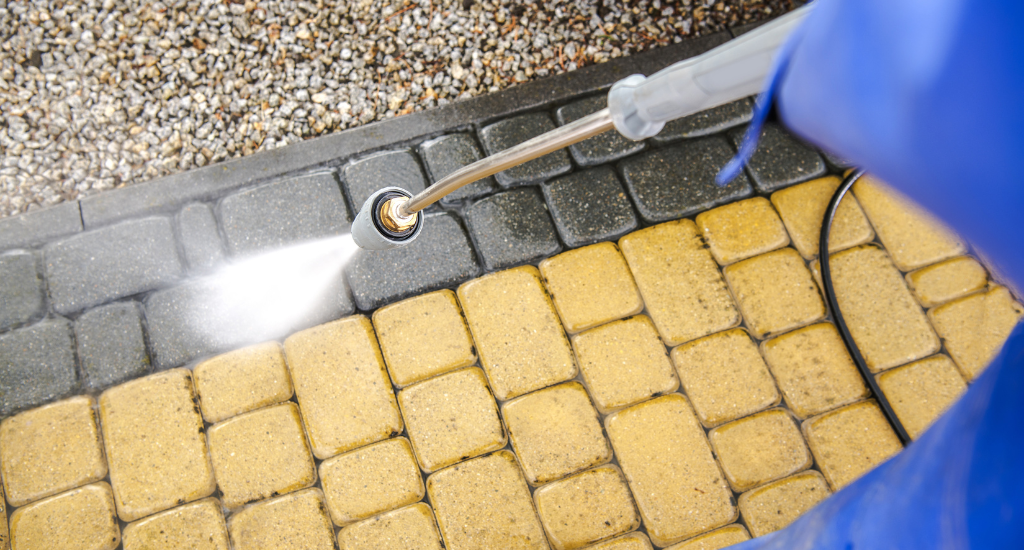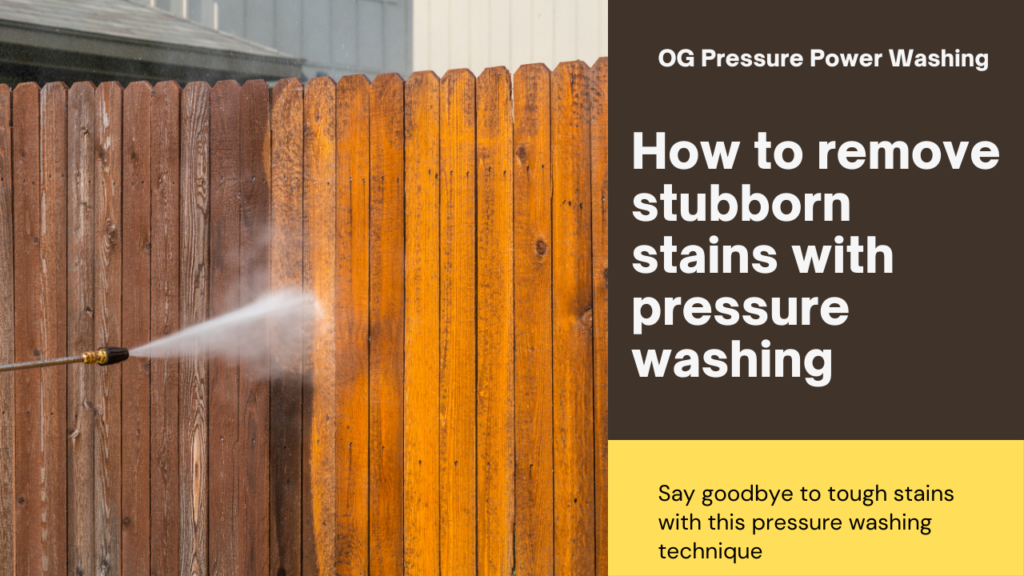Pressure washing is a powerful and efficient method for cleaning various surfaces, from driveways and decks to siding and walkways. This technique uses high-pressure water jets to blast away dirt, grime, and other unwanted substances, making it an ideal solution for removing stubborn stains that other cleaning methods may struggle with. In this article, we will delve into the process of how to remove stubborn stains with pressure washing, offering a comprehensive guide that covers everything from understanding the types of stains to step-by-step instructions and troubleshooting tips.
Understanding Stubborn Stains
Stubborn stains can mar the appearance of any surface, making them look dirty and neglected. These stains come in various forms, each requiring a specific approach for effective removal. Some of the most common types of stubborn stains include oil and grease stains, rust stains, mold and mildew, paint stains, and organic stains like leaves, sap, and bird droppings.
Types of Stubborn Stains
Oil and grease stains are often found on driveways and garage floors, resulting from vehicle leaks or spills. These stains are particularly challenging due to their sticky nature and tendency to penetrate porous surfaces. Rust stains, usually caused by metal objects left on wet surfaces, can leave unsightly reddish-brown marks, especially on concrete and stone. Mold and mildew thrive in damp, shaded areas, leaving black or green patches that can be difficult to eradicate. Paint stains can occur during renovation projects or accidental spills, requiring careful removal to avoid damaging the underlying surface. Lastly, organic stains from leaves, sap, and bird droppings can create stubborn discoloration, especially on outdoor surfaces like decks and patios.
Causes of Stubborn Stains
Understanding the causes of stubborn stains can help in selecting the appropriate removal method. Environmental factors such as rain, humidity, and pollution contribute to the buildup of stains over time. Accidental spills of oil, paint, or other substances can quickly turn into persistent stains if not addressed promptly. Regular wear and tear, combined with the natural aging of materials, also contribute to the development of stubborn stains on various surfaces.
The Science Behind Pressure Washing
Pressure washing is an effective solution for removing stubborn stains due to the high-pressure water jets it employs. The science behind pressure washing involves the combination of water pressure and flow rate, which determines the cleaning power of the pressure washer.
How Pressure Washing Works
A pressure washer uses an electric or gas-powered motor to drive a pump that pressurizes water from a garden hose, forcing it through a narrow nozzle at high speed. The force of the water jet dislodges dirt, grime, and stains from surfaces, effectively cleaning them. Different nozzles and attachments can be used to adjust the water pressure and spray pattern, making pressure washing versatile for various cleaning tasks.
Benefits of Pressure Washing for Stain Removal
Pressure washing offers several benefits for removing stubborn stains. It is efficient and quick, capable of cleaning large areas in a fraction of the time compared to traditional methods. Pressure washing is versatile and can be used on a wide range of surfaces, including concrete, wood, brick, and vinyl siding. When done correctly, pressure washing is also environmentally friendly, as it reduces the need for harsh chemical cleaners.
Preparing for Pressure Washing
Before starting the pressure washing process, proper preparation is essential to ensure safety and effectiveness. This includes taking safety precautions, selecting the right equipment, and preparing the surface for cleaning.
Safety Precautions and Protective Gear
Safety should always be a priority when using a pressure washer. Protective gear such as gloves, goggles, and sturdy clothing should be worn to protect against debris and water splashes. Electrical safety is also crucial, especially when using electric pressure washers. Ensure that all electrical connections are waterproof and use a ground fault circuit interrupter (GFCI) to prevent electrical shocks.
Equipment Selection
Choosing the right pressure washer is vital for effective stain removal. Pressure washers come in various sizes and power levels, measured in PSI (pounds per square inch) and GPM (gallons per minute). For most residential cleaning tasks, a pressure washer with a PSI between 1,500 and 3,000 and a GPM between 1.5 and 2.5 is suitable. Additionally, selecting the appropriate nozzle and attachments, such as surface cleaners or detergent tanks, can enhance the cleaning process.
Surface Preparation
Proper surface preparation can make the pressure washing process more effective. Clear the area of any loose debris, such as leaves or dirt, that could interfere with the cleaning process. For particularly stubborn stains, pre-treating the surface with a suitable cleaning solution can help to loosen the stain before pressure washing.
Step-by-Step Guide to Removing Stubborn Stains
Removing stubborn stains with pressure washing involves a systematic approach to ensure thorough and effective cleaning. Follow these steps for optimal results.
Assessing the Stain
Begin by assessing the type of stain and the surface material. Identifying the stain will help in choosing the appropriate cleaning solution and pressure settings. For example, oil stains may require a degreaser, while mold and mildew may need a bleach-based solution.
Setting Up the Equipment
Assemble the pressure washer according to the manufacturer’s instructions. Select the appropriate nozzle and attachment for the stain type and surface. Adjust the pressure settings based on the material of the surface to avoid damage.
Initial Rinse
Start with a low-pressure rinse to loosen dirt and debris. This step helps to prepare the surface for deeper cleaning. Ensure even coverage by moving the nozzle in a sweeping motion across the surface.
Applying Cleaning Solution
Choose the right cleaning solution for the specific stain. For oil stains, a degreaser is effective, while bleach-based solutions work well for mold and mildew. Mix the cleaning solution according to the instructions and apply it using the pressure washer’s detergent tank or a separate sprayer. Allow the solution to penetrate the stain for the recommended time.
Pressure Washing the Stain
Gradually increase the pressure and use the correct nozzle for the stain. A 25-degree nozzle is suitable for general cleaning, while a 15-degree nozzle is better for tougher stains. Maintain the right distance and angle from the surface, usually about 12-18 inches, and use a consistent, sweeping motion to avoid streaks and uneven cleaning.
Post-Wash Inspection
After pressure washing, inspect the surface for any remaining stains. If necessary, repeat the process for stubborn spots. Rinse off any residual cleaning solution to prevent damage to the surface.
Final Rinse and Drying
Conduct a thorough final rinse with clean water to remove any leftover cleaning solution and debris. Allow the surface to air dry completely. For surfaces like concrete or wood, consider applying a protective sealant to prevent future stains and extend the surface’s lifespan.
Tips and Tricks for Effective Stain Removal
To ensure effective stain removal with pressure washing, consider these additional tips and tricks:
Using Hot Water Pressure Washers
For oil and grease stains, using a hot water pressure washer can significantly improve cleaning effectiveness. Hot water helps to break down and dissolve grease more efficiently than cold water.
Eco-Friendly Cleaning Solutions
Opt for eco-friendly cleaning solutions to minimize environmental impact. These solutions are biodegradable and non-toxic, making them safe for plants, animals, and humans.
Specialized Attachments
Employ specialized attachments like surface cleaners or rotating brushes for hard-to-reach areas or large surfaces. These attachments can enhance the cleaning process and improve efficiency.
Regular Maintenance
Regular pressure washing can prevent stains from becoming stubborn and difficult to remove. Incorporate pressure washing into your routine maintenance schedule to keep surfaces clean and well-maintained.
Troubleshooting Common Issues
Even with the best preparation and techniques, you may encounter some common issues when using a pressure washer to remove stubborn stains. Here are some troubleshooting tips to address these problems:
Dealing with Streaks and Uneven Cleaning
Streaks and uneven cleaning can occur if the nozzle is held too close to the surface or if the pressure settings are too high. To avoid this, maintain a consistent distance from the surface and use a sweeping motion. Adjust the pressure settings as needed to ensure even cleaning.
Handling Tough Stains
For exceptionally tough stains that don’t come off easily, consider using a higher pressure setting or a more concentrated cleaning solution. Allow the solution to sit on the stain for a longer period before rinsing. In some cases, manual scrubbing with a brush may be necessary to loosen the stain.
Addressing Potential Surface Damage
Different surfaces require different pressure settings to avoid damage. For example, wood surfaces can be damaged by high pressure, while concrete can withstand higher settings. Always test the pressure washer on a small, inconspicuous area before proceeding with the entire surface.
Adjusting Techniques Based on Surface Material
Adapt your pressure washing techniques based on the material of the surface. For wood, use a lower pressure setting and a wider spray pattern to avoid splintering. For concrete and brick, higher pressure and a narrower spray pattern can be used for effective cleaning.
Unlock the Power of Pressure Washing – Your Key to Stain-Free Surfaces!

Removing stubborn stains with pressure washing is an efficient and effective method for maintaining the cleanliness and appearance of various surfaces. By understanding the types of stains, preparing the surface, and following a systematic approach, you can achieve excellent results. Regular pressure washing not only enhances the aesthetic value of your property but also contributes to the longevity and safety of surfaces. Whether you are dealing with oil stains on your driveway, mold on your siding, or rust on your patio, pressure washing offers a versatile and powerful solution.
If you find the task too daunting or time-consuming, consider seeking professional help. Professional pressure washing services have the expertise and equipment to handle even the toughest stains, ensuring your surfaces look their best. By incorporating pressure washing into your regular maintenance routine, you can keep your property clean and stain-free for years to come.

